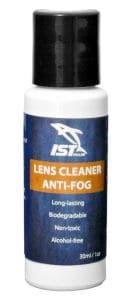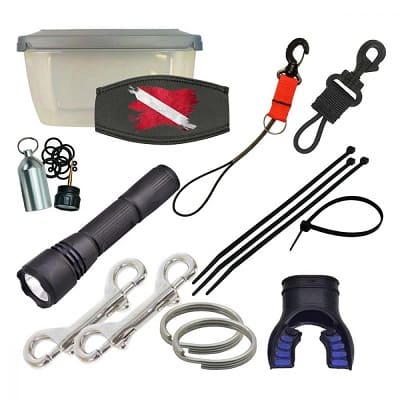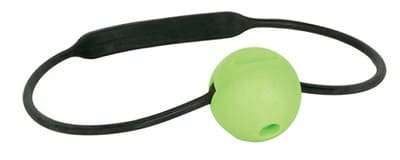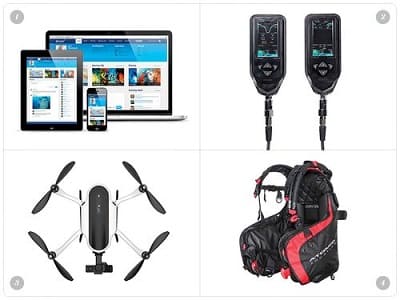Home › A to Z of Scuba Information › Dive Gear › Accessories
Scuba Diving Accessory Packages
A wide range of scuba diving accessories, gadgets, and gizmos add to the fun and enjoyment of the dives - but not necessarily to the safety.
This section will help you accessorise the standard dive gear with some must-have essential add-ons and extras to increase your comfort level.
Marking Your Dive Gear and the Accessories
Most divers like to separate their personal matching gear and gadgets from the rest - especially on dive boats.
So, it's always good practice to personalise your dive stuff by marking and labeling scuba gear for easy identification.
Use a scuba gear marker to label your equipment and accessories (e.g. with marking paint, crayons, or even coloured tape).
We suggest tagging scuba diving accessories somewhere out of sight to others, such as writing your initials on the inside pocket of your fins.
Pro Tip: Being able to recognise equipment and fun scuba accessories helps to prevent frustration and confusion when there's a lot of divers using similar gear brands. It happens more often on scuba diving liveaboard trips and on busy dive boats at popular resorts.
A-Z List of Scuba Diving Accessories
This comprehensive list of trendy, indispensable, scuba diver accessories should help to enhance your participation in the sport. Please contact our scubapro by email if you have any questions or comments.
AF3 Anti-Fogger Gel
What do anti-fog products do? In simple terms, they help to prevent fog-like condensation (small droplets of water) appearing on glass surfaces (e.g. scuba masks).
A good application of anti-fog gel defogger should last a long time. So, you shouldn't need to reapply it for multiple dives made on the same day.
 Key Features
Key Features
- 1-ounce (30 mL) bottle
- Long-lasting, non-toxic, alcohol-free gel formula
- Biodegradable
AF4 Anti-Fog and Lens Cleaner
Key Features
- Two-in-one formula has both an anti-fogger and lens cleaner
- 1-ounce (30 mL) bottle
- Long-lasting, nontoxic, alcohol-free formula
Fun Fact: NASA first developed anti-fog treatments during Project Gemini in 1965. No wonder the diving industry adopted a simple innovation that keeps dive masks free from fogging.
Clips and Hooks
Some of the important safety items used by scuba divers are small, versatile, and inexpensive. But, many of them provide different ways for securing your gear.
This guide lists an assortment of scuba retractors, dive clips, reels, spools, and various other attachments used for enhancing safe diving practices.
Compass
Divers use an underwater compass and natural navigation (e.g. observation techniques) to help them reach a destination point when diving.
Underwater Navigation
This guide contains a list of underwater navigation equipment used in scuba diving, with simple tips for new divers about how to use a compass to navigate underwater.
DIN to Yoke Adapter
Having a universal DIN-to-Yoke converter means you can mount a regulator that has a DIN assembly onto a scuba cylinder that has a standard yoke-style valve. PSI DIN to Yoke adapters:
- Are made from highly polished chrome plating over marine brass.
- Convert the male DIN fitting on a diving regulator to a yoke style fitting.
- Are essential scuba accessories for divers that travel with their own gear.
- Remove the need to carry specialised tools.
Pro Tip: Because this apparatus can convert all DIN regulators back to yoke, divers should consider these scuba diving gadgets as vital accessories to include in a save-a-dive kit.
Dive Flags and Floats
Divers float coloured flags at the surface of the water to alert boat traffic about their presence below and they may soon be making an ascent.
Check out how to use a dive flag and float (the red and white 'diver down' and the blue and white 'alpha flag') to warn boaters that scuba divers are in the area.
Floating Line Holder
Someone needs to take care of the dive flag right? A good scuba float line holder will have up to thirty (30) metres (100 feet) of line and notches so you can 'lock' it off.
Dive Knives and Tools
A dive knife is a general tool and a safety device for scuba divers and in spearfishing. You can use it to cut yourself free, such as if you get entangled underwater.
Find out what a scuba diving knife is used for, which are the best dive knives for beginners, and we list the top rated dive knives with reviews from our team.
Dive Lights
To provide illumination at night, you need at least one dive light as a primary light source. During the day, you can use an underwater torch to look into cracks and crevices.
This section explains what kind of lights scuba divers use and the key styles and features to look for when choosing the best dive light for your budget.
Dry Bags
Dry bags are a handy accessory for protecting personal belongings from getting wet, such as when scuba diving or snorkeling from a boat or the shore.
This guide lists an assortment of waterproof dry bags used by divers and snorkelers with specific reviews about the sizes and useful features.
Fire Escape Hoods
Wearing a fire escape hood over your head and neck creates a tight seal and prevents smoke from getting inside.
Thus, you breathe air through a filter that removes toxic gases found in smoke. The device can give you up to fifteen (15) minutes of clean and safe air.
Pro Tip: Our "Diving Health and Safety Guide" outlines the underlying causes of blazes and raging infernos on diving boats, especially liveaboard vessels, and how to safely evacuate a burning boat.
First Aid Supplies
Barrier Devices
Barriers and shields protect rescuers against disease transmission and contact with unsafe body fluids (e.g. when assisting a bleeding diver).
Check why barrier devices in scuba diving are important and what kind of shielding protection is available for laypersons.
Customising a First Aid Kit
The alliance between effective teamwork and the use of specialised equipment in an emergency response reduces the risks for rescuers and the victims.
Check out how adding specialised first aid supplies to a regular kit can improve outcomes when managing diver emergencies.
Simulation Manikins
Gear Bags
There are several ways to transport scuba equipment, especially if you travel. But, most divers will invest in a sturdy carrier or container to keep the kit safe and dry.
This section contains a list of different gear bags used by scuba divers and we review the best scuba diving bags available online in 2024.
GPS Rescue Devices
There are several reasons why some scuba divers carry a PLB underwater. But, the most important is the ability to send out an emergency distress signal.
Click through for the guide that explains how Personal Locator Beacons work in water, which PLBs are best (e.g. Garmin, Nautilus) and the key differences between PLB and EPIRB.
Lift Bags
Imagine you need to reclaim a heavy and bulky object from the bottom of the ocean and raise it up to the surface, such as an outboard engine. How would you do it?
This section explains what a lift bag is, how it works, and how to use the two different kinds of "open" and "closed" lift bags for salvaging valuable items underwater.
Log Books and Slates
Having a diver's log book is a handy way of recording, and storing, information about diving experiences, including maximum depths and points of interest.
This guide explains how scuba divers should log the dives, what options they have for logging them (e.g. paper vs. digital apps), and how to use plastic writing slates.
Personal Carbon Monoxide Detector
A Carbon Monoxide (CO) single gas detector can provide up to two (2) years of continuous operation. The wearable device gives alerts if Carbon Monoxide (CO) exceeds the surrounding safety levels.
Pro Tip: Our "Diving Health and Safety Guide" outlines the underlying causes of fires on diving boats and explains how to safely escape a smoke-filled boat.
Save a Dive Kit
All divers should store a few spare parts inside a sturdy waterproof box so they can fix minor gear failures and 'save the dive'.
The type of gear you use will determine the contents and how comprehensive it needs to be. But, a basic scuba repair kit should include:
- Batteries (assorted)
 Clips
Clips- Cutting tool
- Defog (see above)
- Dive computer battery
- Fin straps and buckles
- First aid supplies
- Lanyard
- Mask
- Mask strap
- O-ring seals
- Regulator mouthpiece
- Silicone grease
- Snorkel keeper
- Superglue
- Torch batteries
- Zip ties
Pro Tip: Go ahead and browse through our Save a Dive kit list for even more inspiration to get dive ready and prepared to handle last minute equipment emergencies.
Snorkel Vest
Flotation vests for snorkeling are small lightweight inflatable jackets. Often, snorkelers will wear a vest for snorkeling to increase buoyancy and to enable safe relaxation at the surface of the water.
Surface Signaling Devices
Safety conscious scuba divers deploy a variety of gadgets and specialised gear so they get noticed after coming up from a dive (e.g. a safety sausage, whistle).
This collection of audible and visual attention-seeking surface devices spotlights different types of SSDs used in scuba diving and why some are better than others.
Tank Banger, Rod, and Rattler
XS Scuba Tank Banger
When you hear "clank clank" underwater, most divers know exactly what the sound means. Yes... someone wants your attention!
No matter whether you agree with it or not, they are popular with some dive guides for pointing out marine animal life in our Blue Planet.
 Ideal for diver communication underwater
Ideal for diver communication underwater- Colour: neon green
- Fits 17.5 to 20.3 centimetre cylinder diameters (6.9 to 8.0 inches)
- Install around the bottom of a dive cylinder
Tank Banger Rods
Being made of solid aluminium alloy material, means the best banger rods will be durable and resistant to corrosion (rust). Plus, it becomes a handy underwater measuring tool if your scuba tank banger rod has scale calibration.
In general, these rods will be used to point out interesting sea life creatures to divers in the group. But, you can also use these cool diving gadgets to attract attention or to anchor yourself to strong structures (e.g. in drifting currents).
Underwater Scooter (DPV)
There are several reasons why some divers prefer to dive with an underwater propulsion scooter. But, one common reason is to reduce finning so the air supply lasts longer.
This section explains what is a Diver Propulsion Vehicle (DPV), how they work, and why some underwater scooters are better than others - especially for beginners.
 Related Information and Help Guides
Related Information and Help Guides
- BCD Parts List and Maintenance
- Best Dive Knives [2024 Reviews]
- Best Examples of Surface Signalling Devices
- Best Scuba Mask for New Divers
- Diving Flippers: Fins for Divers
- Dry Suit Diving vs. Wetsuit
- List of Scuba Dive Equipment for Beginners
- Scuba Dive Computer Watch Review
- Scuba Regulators Questions and Answers (FAQ)
- Scuba Tank Markings Explained